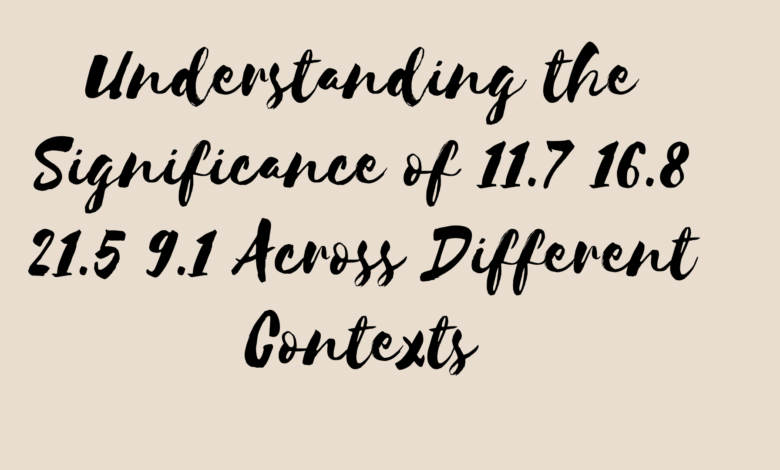11.7 16.8 21.5 9.1

Introduction: What Do 11.7, 16.8, 21.5, and 9.1 Mean?
Have you ever come across a sequence of numbers that didn’t seem to make sense at first? Numbers like 11.7, 16.8, 21.5, and 9.1 might seem random, but they actually have significance across various fields. These numbers could represent anything from statistical data to coordinates or even measurements in scientific experiments. In this blog post, we’ll break down what these numbers could mean in different contexts, helping you understand their relevance and how they might be used in the real world.
Understanding these numbers is important, as they might pop up in situations where you need to interpret data, make decisions, or even solve problems. Whether you’re a student, a professional in data science, or just someone curious about numbers, this article will walk you through how 11.7, 16.8, 21.5, and 9.1 play a role in various domains.
Understanding Numbers in Data Analysis: The Building Blocks
In data analysis, every number tells a story. So, what does the sequence “11.7, 16.8, 21.5, 9.1” represent in this context?
Using Numbers for Insights
When analyzing large datasets, you often deal with sequences of numbers. These numbers could represent anything from sales figures, customer satisfaction ratings, or even the number of units sold over time. For example, if these numbers came from a market research survey, they could be measuring the growth of a product over four months, with each number showing sales figures or customer engagement metrics.
One of the primary reasons data analysts use numbers is to extract meaningful insights from raw data. By looking at trends, such as whether numbers are increasing or decreasing, analysts can make predictions. For example, if the sequence of 11.7, 16.8, 21.5, and 9.1 represented quarterly sales, the drop from 21.5 to 9.1 might be a red flag signaling that something went wrong in the last quarter, such as a marketing campaign failure or a supply chain issue.
The Power of Visualization
Numbers are often easier to interpret when presented visually. With graphs and charts, you can see at a glance whether a trend is positive or negative. If these four numbers were plotted on a line chart, they would show a growth trend up to 21.5, followed by a sudden drop at 9.1. This visual representation could make it easier to identify patterns and outliers, which could guide important decisions.
The Role of 11.7, 16.8, 21.5, and 9.1 in Mathematics
Mathematics is full of patterns and relationships, and numbers like 11.7, 16.8, 21.5, and 9.1 can help us understand the world around us better. Let’s explore a few mathematical contexts where these numbers might fit.
Sequences and Series: Finding Patterns
A sequence of numbers is a set of numbers that follow a specific rule or pattern. While 11.7, 16.8, 21.5, and 9.1 do not form a simple arithmetic or geometric sequence, they could still be part of a more complex pattern. For example, in certain types of problems, the numbers might represent results of an iterative process or a non-linear sequence.
Imagine you are analyzing the growth of a plant in a lab experiment. The numbers could represent the height of the plant measured at regular intervals. While the growth rate isn’t constant (showing a rise and then a drop), the overall trend can give you insights into how different conditions (like soil, light, or water) are affecting the plant.
Ratios and Proportions
In mathematics, ratios are used to compare two quantities, and proportions are equations that express the equality of two ratios. Let’s say that these numbers represent parts of a mixture, where 11.7 parts of ingredient A are mixed with 16.8 parts of ingredient B, and so on. By understanding the proportions, scientists or chefs can ensure the recipe or experiment is successful by getting the right balance.
Proportions are also used in scaling—like when you need to resize an object while maintaining the same shape. So, the sequence of 11.7, 16.8, 21.5, and 9.1 could represent dimensions of a model that need to be scaled up or down proportionally.
11.7, 16.8, 21.5, and 9.1 in Real-World Applications
Now, let’s explore some practical scenarios where these numbers could be used. Whether in business, science, or technology, these numbers often play a role in decision-making and analysis.
Finance and Stock Market Analysis
In the world of finance, numbers like 11.7, 16.8, 21.5, and 9.1 could represent important financial metrics. For instance, they might be quarterly earnings per share (EPS) for a company. EPS is a critical number for investors because it gives them an idea of how much profit the company is making for each outstanding share. If a company’s EPS numbers show an upward trend (as in 11.7, 16.8, 21.5), but then drop to 9.1, it could indicate a problem, such as reduced profitability, which might make investors rethink their investments.
Geographic Coordinates and Navigation
Believe it or not, the numbers 11.7, 16.8, 21.5, and 9.1 might even represent geographical coordinates. Geographers and navigators often use a system of latitude and longitude to pinpoint exact locations on the Earth. While these numbers on their own don’t seem like standard coordinates, they could be part of a set that leads to a specific location. For example, the numbers might refer to the latitude and longitude of a remote location or a place of interest on a map.
Technology and Engineering: The Digital Side of Numbers
Tech-driven world, numbers like 11.7, 16.8, 21.5, and 9.1 can have important roles in fields like programming, machine learning, and engineering.
Machine Learning and Data Science
In machine learning, numbers like these could represent “features” in a dataset. Features are individual measurable properties or characteristics of the phenomenon being observed. For example, if you’re working with a dataset to predict housing prices, each number could represent a different feature, such as square footage, number of bedrooms, or proximity to city centers. These numbers feed into algorithms that help predict outcomes based on historical data.
Engineering and Scientific Measurements
For engineers or scientists, numbers like 11.7, 16.8, 21.5, and 9.1 might be measurements taken during an experiment. These could represent anything from temperature readings in a physics experiment to pressure levels in a chemical reaction. The precision of these numbers can be the difference between a successful experiment and an error.
Conclusion
While 11.7, 16.8, 21.5, and 9.1 may appear to be a random set of numbers at first, they are actually highly versatile and meaningful across a wide range of fields. Whether they’re part of a data analysis process, a scientific experiment, or even a financial report, understanding how to interpret these numbers can help you make informed decisions. Numbers, in their various forms, shape much of the world around us—from business trends and market analysis to cutting-edge technology and scientific breakthroughs.
These numbers don’t just exist in isolation—they’re pieces of a larger puzzle that helps us understand the world more clearly. By knowing how to read them, analyze them, and apply them, you can gain deeper insights into everything from finance to physics to machine learning.
FAQs
1. What do 11.7, 16.8, 21.5, and 9.1 mean?
These numbers can represent anything from data points in a statistical analysis to measurements in scientific experiments. Their meaning depends on the context in which they are used.
2. How can I use these numbers in business or finance?
In business and finance, these numbers could represent financial metrics like earnings per share (EPS), growth rates, or sales figures over time. Analyzing their trends can help in decision-making.
3. Can these numbers be coordinates?
Yes, these numbers could potentially be part of geographic coordinates used for navigation, although they would need to be in the proper format (latitude and longitude) to pinpoint exact locations on Earth.
4. Why are these numbers important in machine learning?
In machine learning, numbers like these might represent features or data points used to train algorithms. The model uses these values to make predictions or classify data.
5. Are these numbers related to scientific measurements?
Yes, in scientific fields, such numbers could represent experimental data, such as temperature, pressure, or other physical properties. Accurate measurements are crucial for drawing conclusions in experiments.
By offering a detailed explanation of how 11.7, 16.




